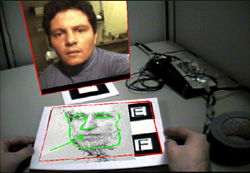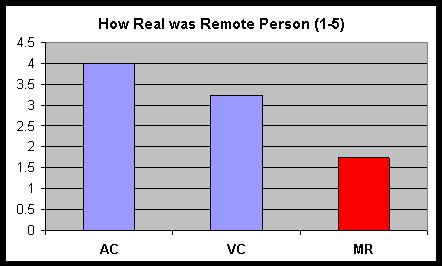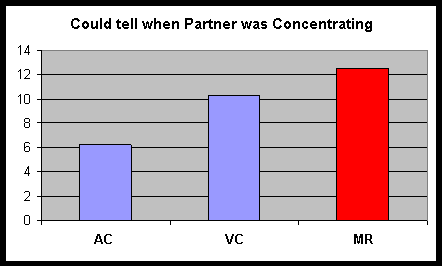

| Publications Page | HITL Home |
Current Conferencing Technology is limited to video conferencing and collaborative virtual environments. Unfortunately, video conferencing suffers from a lack of spatial cues, a limited number of participants, and strictly 2D collaboration. The problem with collaborative virtual environment is that they result in a separation from real world and reduced conversational cues. The goal of Mixed Reality Conferencing is to move conferencing from the desktop to the workspace.
 |
 |
The Experiment
For hardware in this experiment, we used SGI O2, Virtual i-O HMDs, and head mounted cameras. The software included live video, a shared whiteboard, and vision based registration/tracking. Our pilot study attempts to discover how MR conferencing differs. The task was to discuss images in different conferencing conditions. These conditions are ase follows: Audio only (AC), video conferencing (VC), and mixed reality conferencing (MR).
 |
Results
Presence
Subjects asked how present the remote person was.
(0 = they were alone, 100=person in room with them)

Subjects asked how real the remote person was.
(1 = very real, 5 = not very real)

Communication
Subjects were asked if the agreed or disagreed with the statement "I could tell when my partner was copncentrating" (0=disagree, 14 = agree).

Subjects were asked if the agreed or disagreed with the statement "The conversation seemed interactive " (0=disagree, 14 = agree).

Conclusions
Subject Comments:
In MR condition:
Our Subjective Results:
We believe there are a number of confounding factors in this study. First, the task is not strictly conversation. Next, the HMD has limited field of view and resolution. Finally, we were only able to do the test with two users.
Possible applications for this technology include wearable computing, face to face conferencing, and three dimensional CSCW. Future work will include more user testing, multi-party conferencing, and a SIGGRAPH 99 demo (with ATR).
Mark Billinghurst, grof@hitl.washington.edu
Current Conferencing Technology is limited to video conferencing and collaborative virtual environments. Unfortunately, video conferencing suffers from a lack of spatial cues, a limited number of participants, and strictly 2D collaboration. The problem with collaborative virtual environment is that they result in a separation from real world and reduced conversational cues. The goal of Mixed Reality Conferencing is to move conferencing from the desktop to the workspace.
 |
 |

The Experiment
For hardware in this experiment, we used SGI O2, Virtual i-O HMDs, and head mounted cameras. The software included live video, a shared whiteboard, and vision based registration/tracking. Our pilot study attempts to discover how MR conferencing differs. The task was to discuss images in different conferencing conditions. These conditions are ase follows: Audio only (AC), video conferencing (VC), and mixed reality conferencing (MR).Results
Presence
Subjects asked how present the remote person was.
(0 = they were alone, 100=person in room with them)

Subjects asked how real the remote person was.
(1 = very real, 5 = not very real)

Communication
Subjects were asked if the agreed or disagreed with the statement "I could tell when my partner was copncentrating" (0=disagree, 14 = agree).

Subjects were asked if the agreed or disagreed with the statement "The conversation seemed interactive " (0=disagree, 14 = agree).

Conclusions
Subject Comments:
In MR condition:
Our Subjective Results:
We believe there are a number of confounding factors in this study. First, the task is not strictly conversation. Next, the HMD has limited field of view and resolution. Finally, we were only able to do the test with two users.
Possible applications for this technology include wearable computing, face to face conferencing, and three dimensional CSCW. Future work will include more user testing, multi-party conferencing, and a SIGGRAPH 99 demo (with ATR).
Mark Billinghurst, grof@hitl.washington.edu